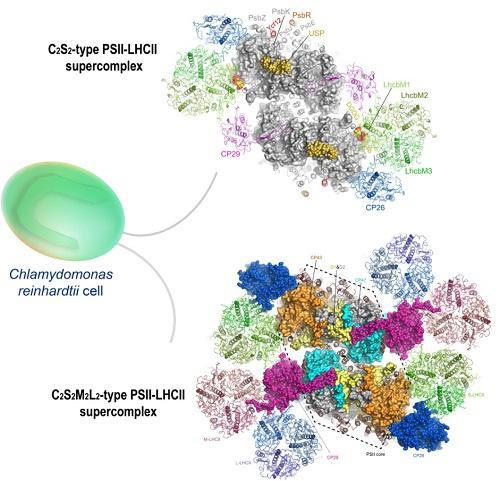Scientists clarify light harvesting in green algae

Structures of C2S2M2L2 and C2S2 -type PSII-LHCII supercomplex from a green algae Credit: Dr. LIU Zhenfeng's group
A new study by Chinese and Japanese researchers has now characterized the light-harvesting system of Chlamydomonas reinhardtii, a common unicellular green alga. This research enhances understanding of the molecular basis for efficient light harvesting as well as photoprotection in green algae under variable light conditions.
The study was conducted by Dr. LIU Zhenfeng's group from the Institute of Biophysics (IBP) of the Chinese Academy of Sciences and Dr. Jun Minagawa from Japan's National Institute for Basic Biology. Results were published online in Nature Plants on Nov. 25, 2019 in an article entitled “Structural insights into light harvesting for photosystem II in green algae.”
Oxygenic photosynthesis in algae and plants relies on photosystem II (PSII) molecules and light-harvesting complex II (LHCII) molecules, and their associated supercomplexes, to convert light energy into chemical energy. For example, PSII catalyzes the splitting of water molecules into oxygen and protons. PSII also assembles with LHCII at the peripheral region to absorb photon energy efficiently.
C. reinhardtii has been an important model for photosynthesis research over the past few decades as well as a platform for the production of high-value products such as biofuel and pharmaceutical compounds. Its LHCII molecules join with PSII molecules to form the C2S2M2L2 supercomplex – the largest known algae or plant PSII-LHCII supercomplex, in addition to the smaller C2S2-type supercomplex.
The researchers solved the structures of both C2S2M2L2 and C2S2 by using cryo-electron microscopy (cryo-EM). They also deciphered in great detail the assembly mechanisms and energy transfer pathways of the two supercomplexes.
Their research shows that the LHCII trimer strongly associated with the PSII core (C) contains three distinct subunits, namely, LhcbM1, LhcbM2 and LhcbM3. Two special lipid molecules mediate the interactions between LhcbM1 and the PSII core antenna CP43.
Furthermore, they discovered that one pair of moderately associated LHCII trimers (M-LHCII) and an additional pair of loosely associated LHCII trimers (L-LHCII) attach at the peripheral region of the C2S2 supercomplex, leading to the formation of the C2S2M2L2 > supercomplex.
By analyzing the structure of C2S2M2L2 supercomplex, the scientists found that the minor antenna complexes CP29 and CP26 contain several green algae-specific regions that are absent in homologs from land plants. They discovered that these special regions on CP29 play a crucial role in linking L-LHCII and M-LHCII and stabilizing the resulting assembly, whereas those of CP26 strengthen its own interactions with S-LHCII (LHCII strongly-associated with PSII).
In addition, using quantitative analysis of chlorophyll-chlorophyll relationships, the team unraveled multiple energy transfer routes from L-LHCII, M-LHCII and S-LHCII to PSII, thus explaining the fundamental steps of the light-harvesting process in green algae.
###
The project was funded by the National Key R&D Program of China, the National Natural Science Foundation of China, the Strategic Priority Research Program and the Key Research Program of Frontier Sciences of CAS, among others.
Media Contact
All latest news from the category: Life Sciences and Chemistry
Articles and reports from the Life Sciences and chemistry area deal with applied and basic research into modern biology, chemistry and human medicine.
Valuable information can be found on a range of life sciences fields including bacteriology, biochemistry, bionics, bioinformatics, biophysics, biotechnology, genetics, geobotany, human biology, marine biology, microbiology, molecular biology, cellular biology, zoology, bioinorganic chemistry, microchemistry and environmental chemistry.
Newest articles

A ‘language’ for ML models to predict nanopore properties
A large number of 2D materials like graphene can have nanopores – small holes formed by missing atoms through which foreign substances can pass. The properties of these nanopores dictate many…

Clinically validated, wearable ultrasound patch
… for continuous blood pressure monitoring. A team of researchers at the University of California San Diego has developed a new and improved wearable ultrasound patch for continuous and noninvasive…

A new puzzle piece for string theory research
Dr. Ksenia Fedosova from the Cluster of Excellence Mathematics Münster, along with an international research team, has proven a conjecture in string theory that physicists had proposed regarding certain equations….



